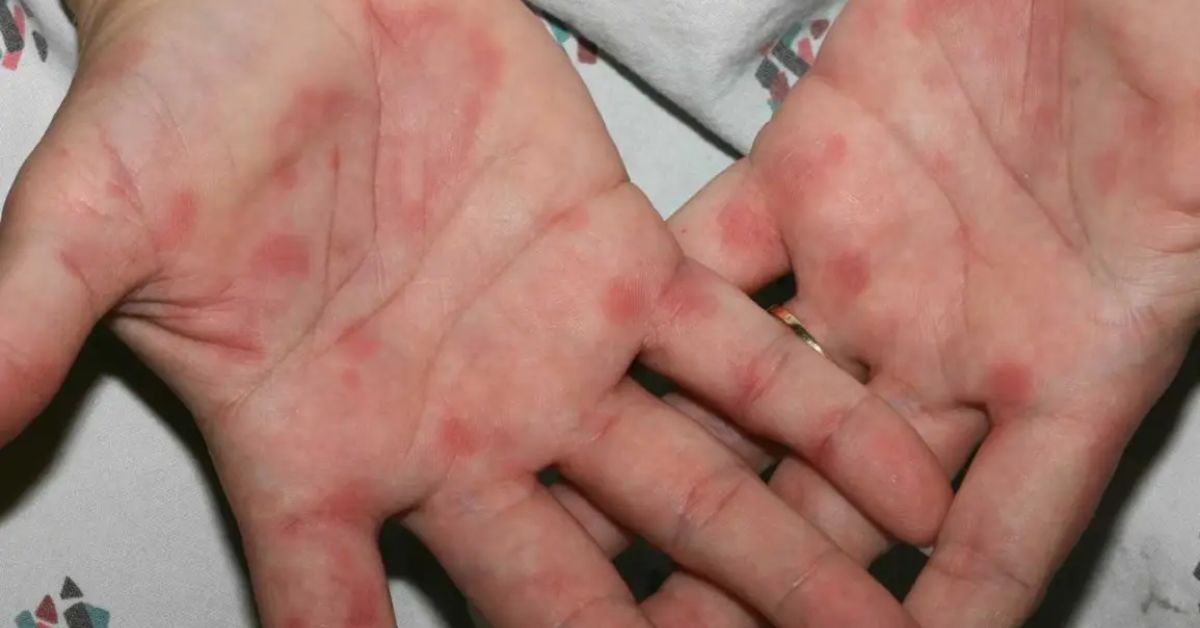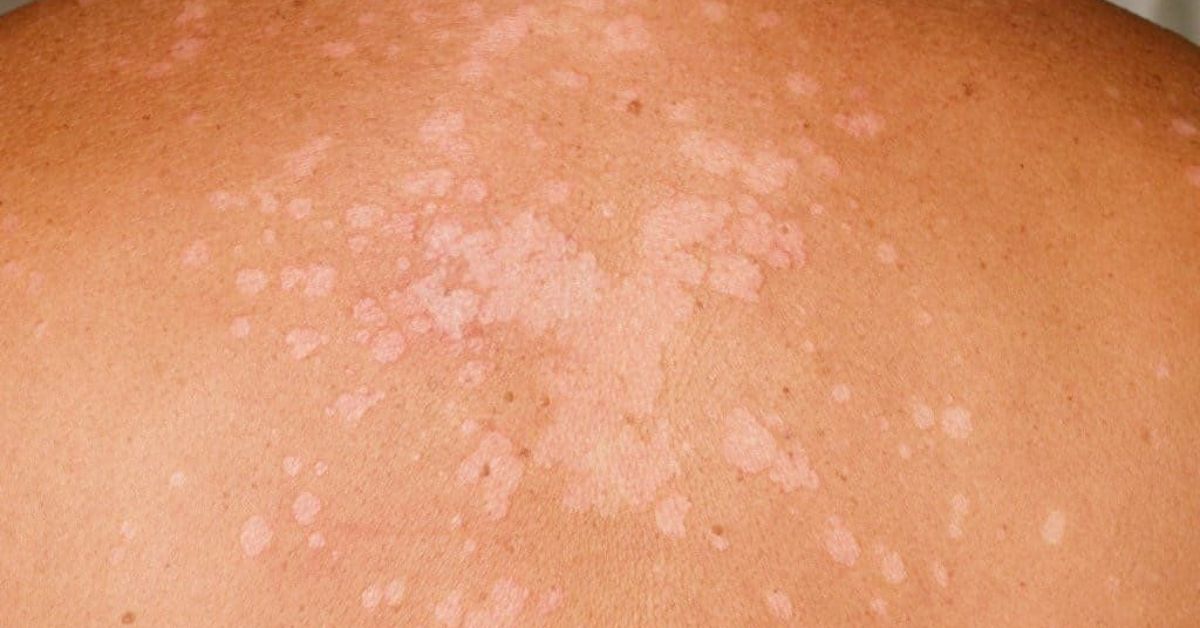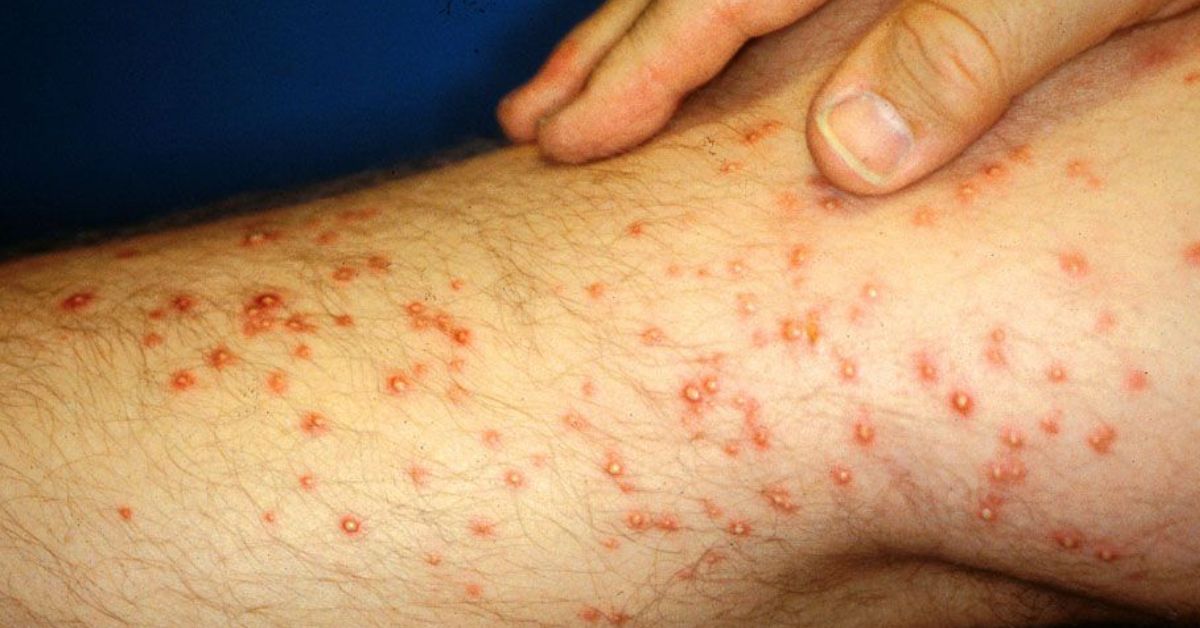The legs are constantly exposed to sunlight and dirt, making them susceptible to various skin issues, one of which is brown spots on the legs. These brown spots not only affect aesthetics but can also serve as warnings for underlying health issues in some cases. What are the causes of this condition? How can it be treated and prevented?
Understanding Brown Spots on the Legs
Brown spots on the legs are areas of darkened skin with diverse sizes and shapes. This condition is quite common and can occur at any age and gender, but it’s more prevalent in older individuals. Brown spots may appear individually or in clustered patches.
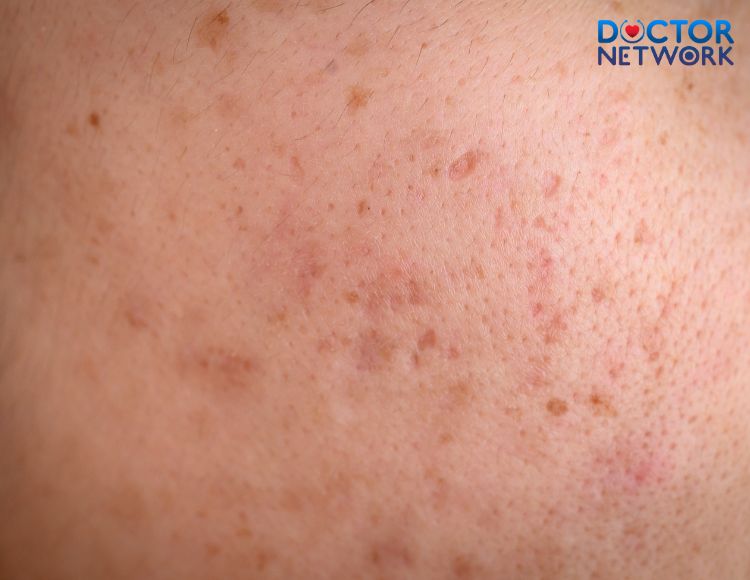
Brown spots may appear individually or in clustered patches
Causes of Brown Spots on the Legs
There are various reasons why brown spots may develop on the legs, including:
- Increased melanin production: Melanin is the pigment that determines skin color. Factors such as sunlight exposure, inflammation, etc., can stimulate excessive melanin production, leading to the formation of brown spots.
- Sun exposure: UV rays in sunlight are the primary factors causing brown spots, freckles, and moles on the skin, especially in individuals without sun protection habits.
- Aging: Natural aging processes reduce skin elasticity and regeneration ability. Alongside, melanin metabolism disorders make brown spots easier to form.
- Other factors: Some factors can increase the risk of brown spots on the legs, such as genetics, endocrine disorders (common in pregnant women), prolonged skin inflammation, medication side effects, etc.
Differentiating Types of Brown Spots
Common types of brown spots on the legs include:
- Freckles: Small, light brown spots often seen in young individuals with fair skin prone to sun exposure.
- Moles: Larger, darker brown spots, sometimes with slightly rough surfaces, commonly appearing with age.
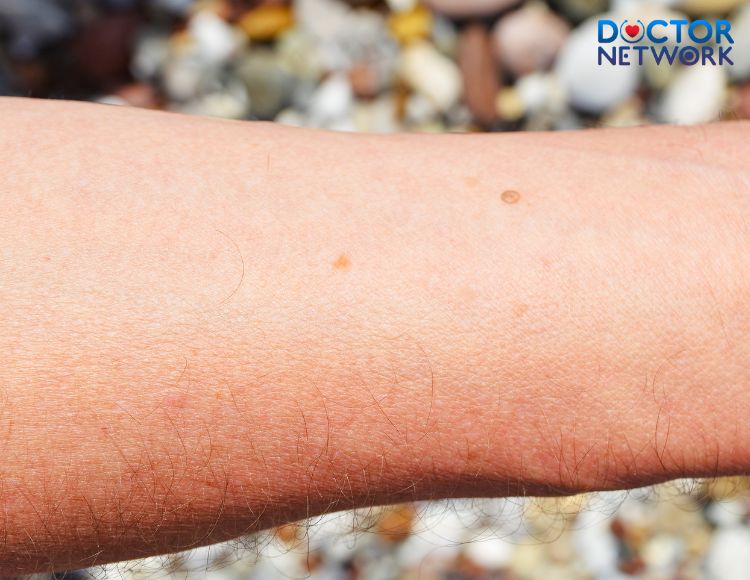
Some common types of brown spots on the legs
- Post-inflammatory hyperpigmentation: Darkened skin areas resulting from injuries (cuts, acne scars, insect bites, etc.).
When to See a Dermatologist
Most cases of brown spots on the legs are benign. However, it’s advisable to consult a dermatologist if you notice the following signs:
- Rapid changes in the size, shape, or color of brown spots.
- Brown spots causing itching, bleeding, or oozing.
- Presence of rough bumps on the surface of brown spots.
Treating Brown Spots on the Legs
Currently, there are several methods to fade brown spots and restore even skin tone. A dermatologist will assess and choose the appropriate treatment method based on the type of brown spots, severity, and individual skin condition.
- Topical medications: External applications containing hydroquinone, tretinoin, kojic acid, etc., inhibit melanin production, lightening brown spots (under dermatologist’s prescription).
- Laser/Intense Pulsed Light (IPL) therapy: Destroys melanin-producing cells, suitable for moles, freckles, etc.
- Chemical peels: Use of acids to remove superficial layers of skin containing excess pigment, promoting skin regeneration.
Preventive Measures for Brown Spots on the Legs
Protecting the skin from sunlight is crucial to prevent brown spots on the legs:
- Limit outdoor activities during peak sunlight hours (10 am – 3 pm). Use broad-spectrum sunscreen with SPF 30+ and wear protective clothing.
- Proper skincare: Keep the skin clean, adequately moisturized, and exfoliate gently.
- Dietary and lifestyle adjustments: Consume foods rich in vitamins C, E, antioxidants, maintain adequate rest, and reduce stress.

Consume foods rich in vitamins C, E, antioxidants, maintain adequate rest, and reduce stress
Some Questions Related to “Brown Spots on the Legs”
Here are some questions related to “Brown Spots on the Legs”:
1. Can brown spots on the legs heal on their own?
Answer: The ability of brown spots on the legs to heal depends on the type of spots and the underlying causes.
– Freckles: They may fade over time with limited sunlight exposure.
– Moles: They often persist and may even darken without treatment.
– Post-inflammatory hyperpigmentation: They may fade on their own, but it can take a considerable amount of time, depending on the initial extent of skin damage.
2. Are brown spots on the legs dangerous?
Answer: In most cases, brown spots on the legs are benign and not dangerous. However, there is a very small risk that some brown spots could be early signs of skin cancer. It’s essential to pay attention if brown spots exhibit abnormal changes in shape, size, color, bleeding, itching, or discomfort. In such cases, prompt dermatological consultation is advised for accurate diagnosis.
3. Is there a safe way to treat brown spots on the legs at home?
Answer: Some natural ingredients like lemon, turmeric, aloe vera, etc., are believed to have skin-lightening properties that may help fade brown spots. However, their effectiveness is limited and not thoroughly proven. Moreover, leg skin is sensitive, so it’s advisable to consult a dermatologist before attempting any at-home treatments to avoid unwanted side effects.
4. Does treating brown spots on the legs take a long time?
Answer: The time required to treat brown spots on the legs depends on the type of spots, chosen treatment methods, and individual factors. Treatments like laser therapy or chemical peels often yield quicker results compared to topical creams. For long-standing brown spots, multiple therapy sessions may be needed to achieve significant improvement.
5. Can brown spots on the legs recur after treatment?
Answer: Brown spots, especially freckles and moles, have a high recurrence risk if the skin is not adequately protected from sunlight. Daily use of sunscreen and proper sun protection measures are essential to maintain treatment effectiveness and prevent the appearance of new brown spots.
Some Scientific Evidence on “Brown Spots on the Legs”
Here are some scientific references regarding “Brown Spots on the Legs”:
1. Article: “Melanin: An Assessment of Biological Function and Synthesis Pathways” (2020) –https://www.ncbi.nlm.nih.gov/pmc/articles/PMC6944209/: Increased melanin pigment can lead to skin issues such as hyperpigmentation, freckles, and moles.
2. Study: “The Role of Melanin in Photoprotection, Oxidative Stress, and Skin Cancer” (2017) – https://www.ncbi.nlm.nih.gov/pmc/articles/PMC7278813/: This study evaluates the role of melanin in protecting the skin from the harmful effects of UV radiation, oxidative stress, and skin cancer.
3. Article: “The Role of Ultraviolet Radiation in the Development of Skin Cancer” (2019) – https://pubmed.ncbi.nlm.nih.gov/20883261/: UV exposure is the primary cause of skin cancer.
Conclusion
Brown spots on the legs are common issues that can be effectively addressed with appropriate measures. The key lies in proactive protection, prevention, and comprehensive skincare awareness.
References:
https://www.webmd.com/skin-problems-and-treatments/what-is-hemosiderin-staining
https://www.healthline.com/health/symptom/dark-spots-on-legs
https://www.centerforvein.com/blog/what-are-those-brown-spots-on-my-legs
Kiểm Duyệt Nội Dung
More than 10 years of marketing communications experience in the medical and health field.
Successfully deployed marketing communication activities, content development and social networking channels for hospital partners, clinics, doctors and medical professionals across the country.
More than 6 years of experience in organizing and producing leading prestigious medical programs in Vietnam, in collaboration with Ho Chi Minh City Television (HTV). Typical programs include Nhật Ký Blouse Trắng, Bác Sĩ Nói Gì, Alo Bác Sĩ Nghe, Nhật Ký Hạnh Phúc, Vui Khỏe Cùng Con, Bác Sỹ Mẹ, v.v.
Comprehensive cooperation with hundreds of hospitals and clinics, thousands of doctors and medical experts to join hands in building a medical content and service platform on the Doctor Network application.
















